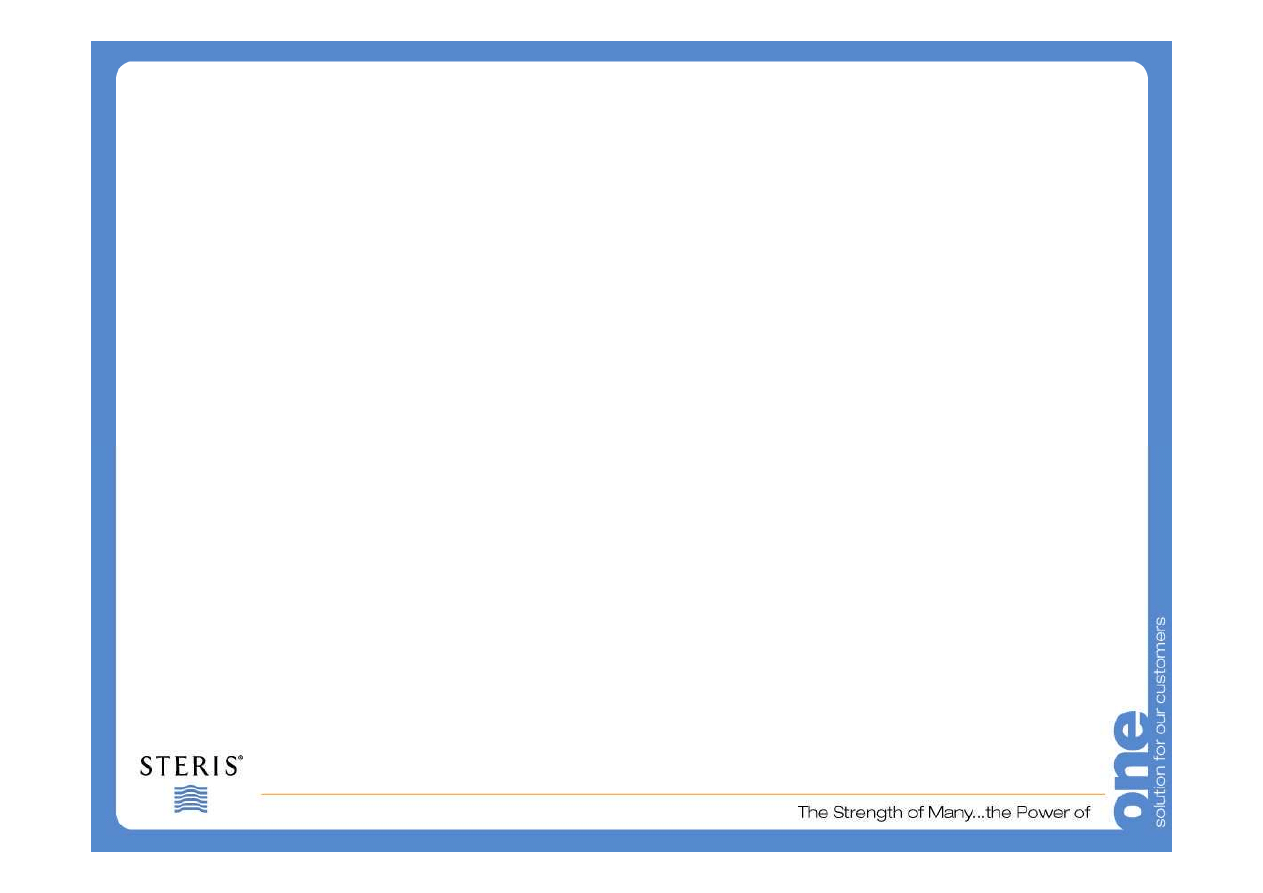
Routine monitoring of the disinfection /
washing process ISO 15883
WFHSS
Oman
1 Nov 2006
Peter Newson

Objectives
Validation
Parametric release
Validation tools
Routine Monitoring
Conclusion

If your cow sounds like this
may we suggest the fish.
If your cow sound like this
then fire up the barbecue.
Public Service Announcement
How to identify if your cow has mad cows disease..

ISO 15883
Regulates the validation of processing sequences in washer
– disinfectors for medical devices as well as
revalidation
and
routine monitoring
of these processes.
IQ,OQ and PQ are now considered to provide only a portion
of the monitoring required to ensure that
consistently
effective
and
reproducible
processes are being
conducted.

Performance qualification
The process of obtaining and documenting evidence that the
equipment, as installed and operated in accordance with
operational procedures,
consistently
performs in
accordance with predetermined criteria and thereby yields
product meeting it’s specification

The most important
positive
and
negative
parameters of
influence include:
̇
mechanical effects
̇
chemical effects
̇
thermal effects
̇
blockage of detergent components
15883 Guidelines

15883 Guidelines
The most important
positive
and
negative
parameters of
influence include:
̇
Protein coagulation
̇
sufficiently long hold times for swelling,
disintegration, hydrolysis (disinfection)
̇
avoidance of recontamination

Parametric Release
Pre-validation of all process variables
Water quantity per process step.
Temperature and holding time
Water pressure
Lumen patentcy
Verification after process that all parameters and
variables were within pre-set defined limits

ISO 15883 General requirements
Although those constitute an indispensable base for your
validation and routine monitoring they do not suffice on
their own
additional quantitative checks of the cleaning
performance must be carried out on a regular basis.

ISO 15883
Preference must also be given to the use of standardised,
quantitatively assessable test models as they yield
reproducible results.
Current national formulations - to a large extent - require the
tests to be individually made by those conducting the tests

Soils
Commercially available soils have approached this goal.
Many laboratory soil formulations have been described
in literature and have recently been consolidated in
the ISO EN standard 15883 Part 5 (regarding test
soils and methods for demonstrating cleaning efficacy
of washer-disinfectors);

Described soil formulations.
Load Type Surgical Instruments
UK soil (‘Edinburgh’)
Blood, egg yolk, mucin
German soil
Blood, egg, semolina, butter, sugar, milk
ASTM soil
Protein with endospores.
Bowls/Dishes
Swedish soil - Coagulated blood

Described Soil formulations
Bedpans
UK bedpan soil(‘Huckers’) Flour, paste, eggs, ink, water
Flexible endoscopes
Biofilm soil - France -
P. aeruginosa
biofilm
German endoscope soil - Blood,
E. faecium

What’s on the instrument?
Following surgical or investigational use soils found on
instruments are complex mixtures of various components.
Organic (or carbon-based) materials like proteins,
carbohydrates, lipids and microorganisms. (e.g. blood,
mucus)
Inorganic (or non-carbon based) materials including various
minerals and salts. Soil may also include some specific
components due to their presence in water used for
reprocessing (e.g., calcium carbonate or scale) and device
damage (e.g., iron oxide or rust).

Soil – Soil removal
Protein – less than 45
o
C
Polysaccerides
Lipids – require high temperatures for effective removal –
often in the presence of detergents
Therefore each stage of the washer disinfector cycle is
equally important.

Commercial soils
There are also a few commercially available soils which have
been specifically developed and validated for use in
cleaning efficacy tests. standardized, easy to prepare (by
dilution in water when needed), reproducible, non-toxic and
stable (as a dried formulation).

Commercial soils

Soils
It should be noted that none of these soils are universally accepted
and that it is intended that a single, best case test soil should be
developed in the future.

Frequency of testing?
Additional quantitative checks of the cleaning
performance must be carried out on a
regular
basis?
Does that mean by load, daily, weekly or monthly?

Options - Cycle
Very few available – apart from the obvious visual
inspection.
Commercially available
“ Load controls”

Load control
Offers consistent ongoing challenge to the process.
Representative test soil
Representative surface
Developed as a worse case
Easy & safe to use
Creates physical evidence of cleaning efficacy within the
department.
However these are not actual instruments used in
procedures

Load control / Daily Soil removal efficacy tests

Daily / weekly tests
Soil removal efficacy test – physically painted onto sample
instruments.

Daily / weekly testing
Physical soil removal efficacy test.
Protein detection testing methods
An example of this would be the Ninhydrin test

Ninhydrin testing
Purple colour development on reaction with proteins peptides
and amino acids
Positive control with arginine
Incubation at 55 – 57
o
C for >5 min / < 60 min
Physical evidence then recorded and saved.

Remember
•
First and foremost you have to go back to your
primary objective –
•
To provide as much evidence as possible that
the correct cleaning / disinfection conditions
were present in each and every basket or item
processed.

Conclusion
•
Each facility is different
•
Everyone of you is different
•
You all have different budgetary constraints
Therefore
Above all else you have to be comfortable, and
confident with the systems you have in place !

Wyszukiwarka
Podobne podstrony:
wfhss workshop20061101 lecture11 en
wfhss workshop20090325 lecture01 02 en
wfhss workshop20071206 lecture05 01 en
wfhss workshop20090325 lecture02 02 en
wfhss workshop20071206 lecture06 02 en
wfhss workshop20090325 lecture01 08 en
wfhss workshop20071206 lecture06 01 en
wfhss workshop20071206 lecture01 02 en
wfhss conf20070503 lecture10 en
wfhss conf20070503 lecture03 en
wfhss conf20070503 lecture09 en
wfhss conf20070503 lecture05 en
wfhss conf20070503 lecture15 en
wfhss conf20091007 lecture sp op03 en
wfhss conf20091007 lecture sp l401 en
wfhss conf20091007 lecture sp s401 training programme en
wfhss conf20091007 lecture sp s401 en
wfhss conf20100730 lecture sp s502 en
wfhss conf20091007 lecture sp s501 en
więcej podobnych podstron